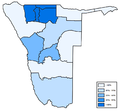| Languages of Namibia | |
|---|---|
 | |
| Official | English |
| National | Afrikaans, German, Otjiherero, Khoekhoegowab, Oshiwambo, RuKwangali, Setswana, SiLozi |
| Recognised | !Kung, Gciriku, Thimbukushu |
| Vernacular | Namlish, Namibian Afrikaans, Namibian German |
| Minority | Fwe, Kuhane, Mbukushu, Yeyi, Naro, ǃXóõ ǂKxʼauǁʼein |
| Immigrant | Portuguese |
| Signed | Namibian Sign Language |
| Keyboard layout | |
Namibia, despite its scant population, is home to a wide diversity of languages, from multiple language families: Germanic, Bantu, and the various Khoisan families. Afrikaans, German, and English had equal status as official languages during the time Namibia was administered by South Africa. Upon Namibian independence in 1990, English was enshrined as the nation's sole official language in the constitution of Namibia. German and Afrikaans were stigmatised as relics of the colonial past, [1] while the rising of Mandela's Youth League and the 1951 Defiance Campaign spread English among the masses as the language of the campaign against apartheid. [2]








